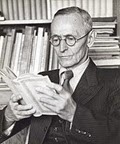Tuesday, August 12, 2014
Coming-of-age
Hermann Hesse
(
1877 – 1962 ) was a German poet,
novelist, and painter. His best-known works include
Steppenwolf, Siddhartha, and The Glass Bead Game *, each of which explores an
individual's search for authenticity,
self-knowledge and spirituality. In 1946, he
received the Nobel Prize in Literature.
Demian had a strong and enduring influence on the generation of
home-returners from the First World War.; similarly, The Glass Bead Game, with its disciplined intellectual world of Castalia and the powers of
mediation and humanity, captivated Germans' longing
for a new order amid the chaos of a broken nation following the loss in Second
World War.
By the time of Hesse's death in 1962, his
works were still relatively unknown in the United States. The
revival in popularity of Hesse's works has been credited to their
association with some of the popular themes of the 1960s counterculture (or
hippie) movement. In particular, the
quest-for-enlightenment theme of Siddhartha (Hesse's Siddhartha is one of the most popular Western novels set in India), Journey to the East,
and Narcissus and Goldmund resonated with those espousing
counter-cultural ideals. The "magic
theatre" sequences in Steppenwolf were interpreted by some as drug-induced psychedelia, although
there is no evidence that Hesse ever
took psychedelic drugs or recommended their use.
Beneath
the Wheel, his second novel, was published in 1906 and was written while he lived
in Gaienhofen
on Lake
Constance.
Peter Camenzind, published in 1904, was the first novel and
contains a number of themes, most notably the individual's search for a unique
spiritual and physical identity amidst the backdrops of nature and modern
civilization and the role of art in the formation of personal identity.
Beneath the Wheel (Unterm Rad) is a 1906 novel.
It is also sometimes titled The
Prodigy in English. It
severely criticises education that focuses only on students' academic
performance.
Demian: The Story of Emil Sinclair's Youth is a Bildungsroman
by Hermann Hesse, first published in 1919; Emil Sinclair is
a young boy raised in a bourgeois home, amidst what is described as a
Scheinwelt, a play on words that means "world
of light" as well as "world of illusion".
Siddhartha , written in 1922, deals with the spiritual journey of
self-discovery of a man named Siddhartha during the time of the Gautama
Buddha.
Steppenwolf (orig. German Der Steppenwolf) was
his tenth novel. Originally published in Germany in 1927, it was first translated
into English in 1929. Combining autobiographical and psychoanalytic elements,
the novel was named after the lonesome wolf of the steppes. The story in large
part reflects a profound crisis in Hesse's spiritual world during the 1920s while memorably
portraying the protagonist's split between his humanity and his wolf-like
aggression and homelessness.
Narcissus and Goldmund (also
published as Death and the Lover), 1930, is the story of a young man, Goldmund,
who wanders around aimlessly throughout Medieval Germany after leaving a
Catholic monastery school in search of what could be described as "the
meaning of life", or rather, meaning for his life.
Journey to the East is a
short first published in German in 1932 as "Die Morgenlandfahrt". Journey
to the East is written from the point of view of a man (in the book called
"H. H.") who becomes a member of "The League", a timeless
religious sect whose members include famous fictional and real characters, such
as Plato, Mozart, Pythagoras, Paul Klee, Don Quixote, Puss in Boots, Tristram
Shandy, Baudelaire, Goldmund, a character from Hesse's Narcissus
and Goldmund, and the ferryman Vasudeva,
a character from Hesse's, Siddhartha. A branch of the group goes on a pilgrimage to "the
East" in search of the "ultimate Truth". The narrator speaks of
traveling through both time and space, across geography imaginary and real.
The Glass Bead Game, 1943, The Glass Bead Game takes place at an unspecified
date centuries into the future. Hesse suggested that he imagined
the book's narrator writing around the start of the 25th century. The setting
is a fictional province of central Europe called Castalia, which was reserved
by political decision for the life of the mind; technology and economic life
are kept to a strict minimum. Castalia is home to an austere order of
intellectuals with a twofold mission: to run boarding schools for boys, and to
nurture and play the Glass Bead Game, whose exact nature remains elusive and whose devotees occupy a
special school within Castalia known as Waldzell. The rules of the game are
only alluded to—they are so sophisticated that they are not easy to imagine.
Playing the game well requires years of hard study of music, mathematics, and
cultural history. The game is essentially an abstract synthesis of all arts and
sciences. It proceeds by players making deep connections between seemingly
unrelated topics. The novel is an example of a bildungsroman
("novel of formation/education/culture"), novel of formation, novel of education,
or coming-of-age story)
*also published as Magister Ludi, Latin for "Master of the Game", which is an
honorific title awarded to the book's central character. "Magister Ludi" can also be seen as a pun: lud- is a Latin stem meaning both "game" and "school".
Subscribe to:
Post Comments (Atom)




No comments:
Post a Comment